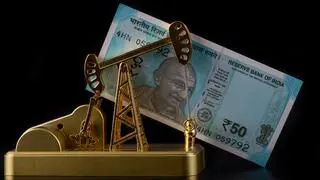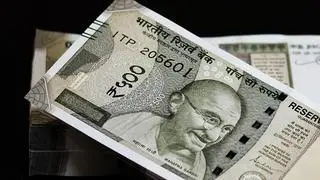India’s GDP is significantly influenced by international trade, with exports and imports combined accounting for over 43.1 per cent of the GDP in 2023. Remarkably, exports account for 20.5 per cent, indicating that one-fifth of the Indian economy is globally competitive and Indian exporters have outperformed global competitors to secure export orders. Can trade, the tail, wag the dog of the Indian economy?
India’s trade ecosystem provides signals that can be leveraged to enhance economic growth. Here are the signals from 2023.
Syncing with global factors
The Department of Commerce released November 2023’s trade statistics on December 15, 2023.
Using historical data and research, we estimate India’s trade for 2023 to dip slightly to approximately $1,609 billion, marking a 2.6 per cent decrease from the previous year. This shift is characterised by a marginal 1 per cent growth in exports, buoyed primarily by a 10.5 per cent surge in services, contrasting with a 5.3 per cent decline in merchandise exports.
India’s trade performance mirrors the global trend of a 5 per cent decline (as per Unctad’s Global Trade Update). According to China Customs data, it aligns with China’s 5.2 per cent drop in merchandise exports during January-November 2023.

Labour-intensive sectors hit
At the product level, the variance was stark. Products that constituted the majority (78 per cent) of India’s merchandise exports faced negative growth. Essential products in this category include Engineering Goods, Chemicals, Gems and Jewellery, Readymade Garments, Plastic, Marine Products, Leather, and Tea.
The main reason for the decline is competition from low-cost countries like Bangladesh and Vietnam. The decline happened despite the Rupee depreciating by 6 per cent against the US Dollar between June 2022 and June 2023.
The performers
Products that form 22 per cent of exports — Electronic Goods, Drugs and Pharmaceuticals, Rice, Ceramic Products and Glassware, Meat, Dairy and Poultry Products, Spices, Iron Ore, Fruits and Vegetables, Tobacco, and Coffee — grew.
A major success story was the export of smartphones, where export is expected to double to $14 billion in 2023 over 2022. However, imports of electronic goods continued to grow, including a substantial increase in the import of electronic components.
Services exports shine
Services masked the decline in merchandise exports. In 2023, services exports are set to grow by 10.5 per cent. This growth is led primarily by software and IT services, about 40 per cent, and business services, about 25 per cent of India’s service exports.
Business services have benefited from establishing over 1,500 Global Capability Centres (GCCs) by large global firms, employing around 1.3 million people.
However, the key to sustained growth in the services sector lies in diversification, focusing on non-IT sectors such as tourism, healthcare, education, and audio-visual services.
Additionally, there’s a pressing need to establish robust systems for accurately capturing service data. This is crucial as discrepancies between Indian data and data from other countries indicate significant variances in many sectors.
FTA factor
India is in the advanced stages of negotiating FTAs with the UK, Oman, and the Indo-Pacific Economic Framework (IPEF). Ongoing negotiations also include the European Free Trade Association (EFTA), European Union (EU), Eurasian Economic Union (EAEU), Israel, Sri Lanka, and Peru.
The new FTAs include Sustainable Development and Digital Economy, Intellectual Property Rights, Labour, Gender, Micro, Small and Medium Enterprises (MSMEs), Government Procurement, and Competition, which may restrict policy space for domestic regulations.
Trade deficits from most FTA partner countries have increased more than India’s global trade deficit in the past decade. Negotiators must focus on obtaining real market access on the ground. A study on gains from the Indian FTAs, implemented so far would be a useful guide for everyone.
WTO ministerial
Not much is expected from MC13, but India must keep guard.
The upcoming 13th Ministerial Conference of the WTO in February 2024 in Abu Dhabi presents India with an opportunity to address critical issues like public stockholding for food security.
The current WTO Agreement on Agriculture (AoA) places restrictions on India’s ability to maintain and purchase foodgrains at administered prices, a crucial aspect of ensuring food security for its population. India advocates for a permanent exemption, akin to the “peace clause” temporarily agreed upon at the Bali Ministerial Meeting in 2013.
Other issues of India’s concern relate to the pursuit of a Special Safeguard Mechanism (SSM) to protect its farmers from abrupt increases in agricultural imports, the e-commerce moratorium, equitable outcomes in fisheries negotiations, and the reform of the WTO’s Dispute Settlement System. The WTO includes newer areas outside of trade and does nothing in any area.
US, EU pressure
In 2023, the US and the EU proposed charging countervailing tariffs on several Indian products on allegations that these products benefited unfairly from Indian government schemes, thereby harming industries in the importing countries.
With increasing trade protections in the EU and the US, such cases are likely to grow, especially with policies like the EU’s Carbon Border Adjustment Mechanism (CBAM) potentially imposing additional 20-35 per cent additional tariffs. India must take countermeasures. The US and EU implement many WTO non-compatible subsidies to their industries and agriculture sectors.
Set up exchanges for exports in local currencies. The local currency trading could reduce trade transaction costs by 2-3 per cent. Government fixed rates in the long past have resulted in manipulation.
E-commerce exports will increase with simplified procedures. Without significant simplification, most e-commerce trade is likely to be import-driven.
2024 may be tough on trade but there is silver lining. The WTO projects a 3.3 per cent increase in global trade in goods but UNCTAD, IMF, and the World Bank do not agree.
Given India’s relatively small share in world trade (around 2 per cent), focusing on labour-intensive sectors, diversifying services and not losing policy space through FTAs could significantly increase trade performance. The action plan should consider predictions that by 2030, India’s GDP will exceed Japan’s, opening up many local and international growth opportunities.
The writer is the founder, the Global Trade Research Initiative








Comments
Comments have to be in English, and in full sentences. They cannot be abusive or personal. Please abide by our community guidelines for posting your comments.
We have migrated to a new commenting platform. If you are already a registered user of TheHindu Businessline and logged in, you may continue to engage with our articles. If you do not have an account please register and login to post comments. Users can access their older comments by logging into their accounts on Vuukle.